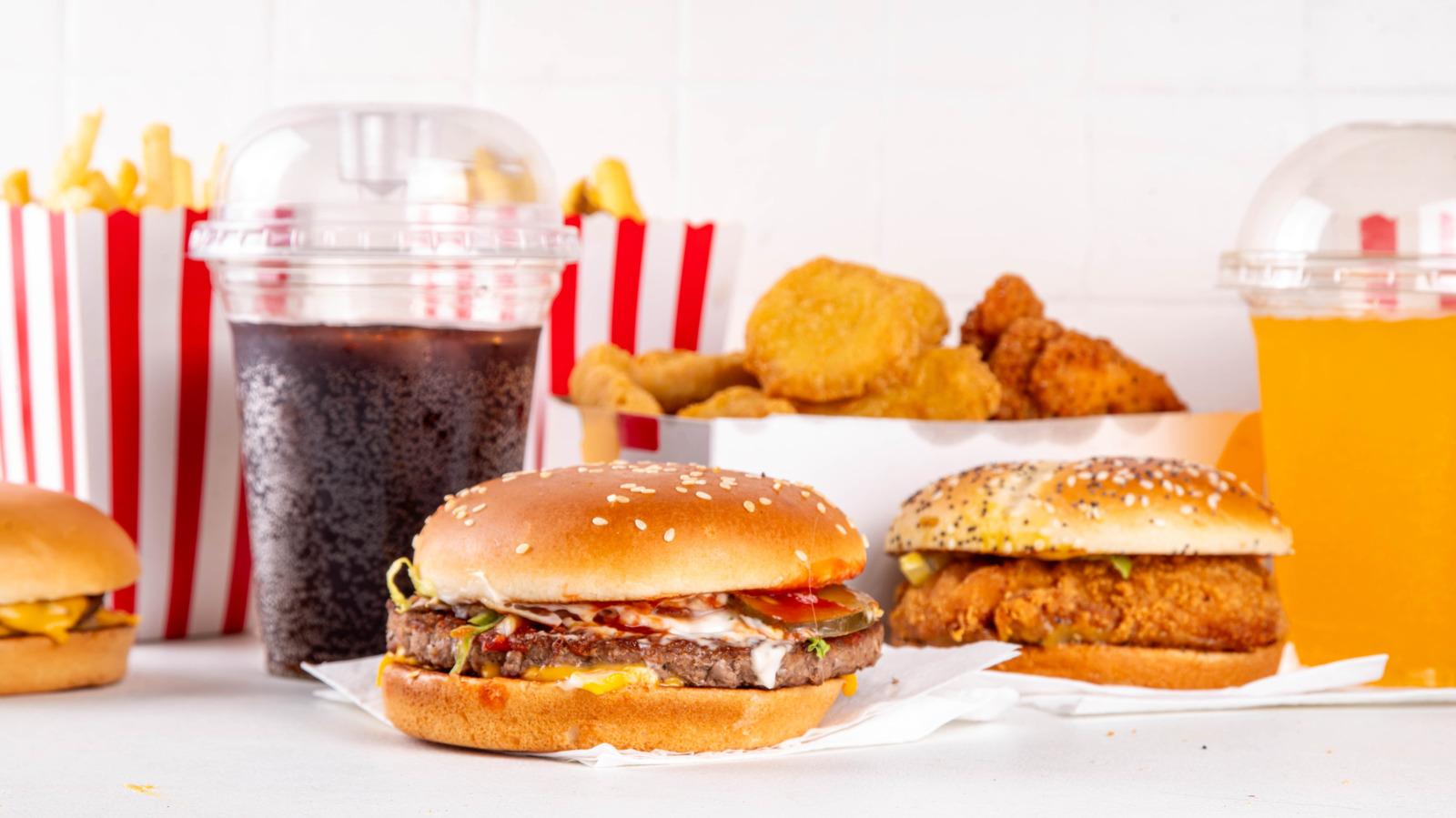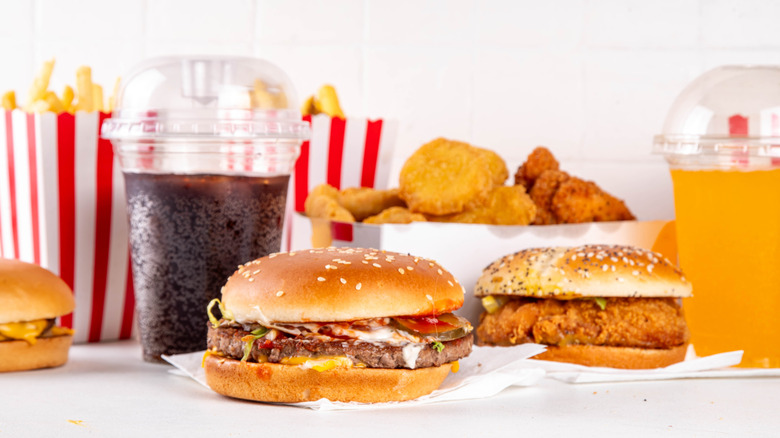
Rimma Bondarenko/Shutterstock
Fast food is deeply ingrained in our diets today. According to a 2025 YouGov survey, 25% of Americans eat multiple fast food meals per week, while 35% are a bit more restrained and order fast food multiple times per month. Despite the common knowledge that fast food rarely offers significant nutritional value, people still buy it because it's affordable, accessible, and convenient — this is where the Food and Drug Administration comes in.
The FDA has a broad mandate of protecting the health of the American people by ensuring that medical drugs and devices, cosmetics, radiation-emitting products, and food are safe for use and consumption. Matters concerning fast food products, like how they are prepared and the ingredients used to make them, are under the jurisdiction of the FDA.
The agency gives guidelines and recommendations for food preparation. Though it sometimes gets called out for allowing flexibility on how certain guidelines are interpreted, when serious public health concerns emerge, the FDA enforces stern regulations that give fast food chains no choice but to comply. Let's take a look at some of the FDA's food safety rulings that have pushed fast food establishments to change their menus.
Fast food chains started listing the calories per serving of their menu items
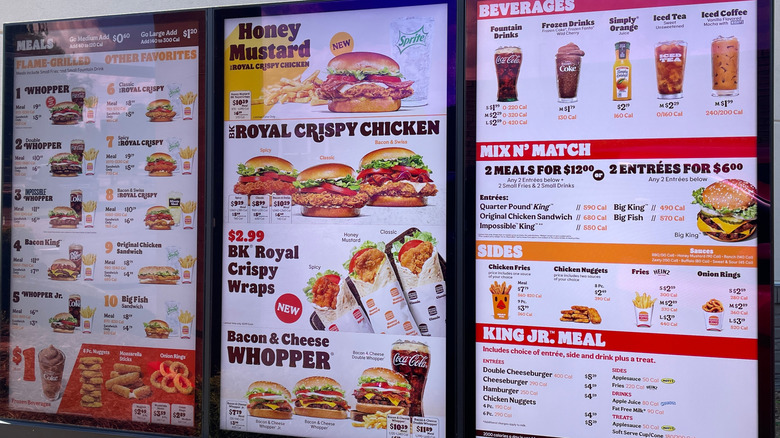
Billy F Blume Jr/Shutterstock
In an effort to help Americans make informed dining decisions whenever they eat out, in 2010, the FDA made it mandatory for large food establishments (chains with 20 or more locations) to add calorie counts to their menus. This law was part of the Affordable Care Act (ACA) and was meant to help people be mindful about what they order when dining at a restaurant or buying fast food.
Even though the law wasn't fully implemented until May 2018, large food chains followed the FDA regulation soon after it was introduced. McDonald's listed calorie information on its in-store and drive-thru menu boards in 2012. By the end of 2018, other fast food chains like Chipotle, Burger King, Wendy's, Denny's, KFC, and more were already compliant.
The guidance was a timely move for the FDA. Since 2011, Americans have been eating out more than buying fresh ingredients and cooking meals at home. And when eating out, many unknowingly eat more than their daily recommended calorie intake. For example, one Big Mac has 580 calories, which is already 25% of the daily caloric recommendation for the average adult woman. If a customer had a large vanilla shake to go with it, that's an additional 780 calories. Not everyone takes advantage of the transparency available regarding fast food nutrition, but the now-widespread accessibility of caloric information makes it easier to make informed decisions.
McDonald's briefly stopped serving Quarter Pounders at 20% of its stores
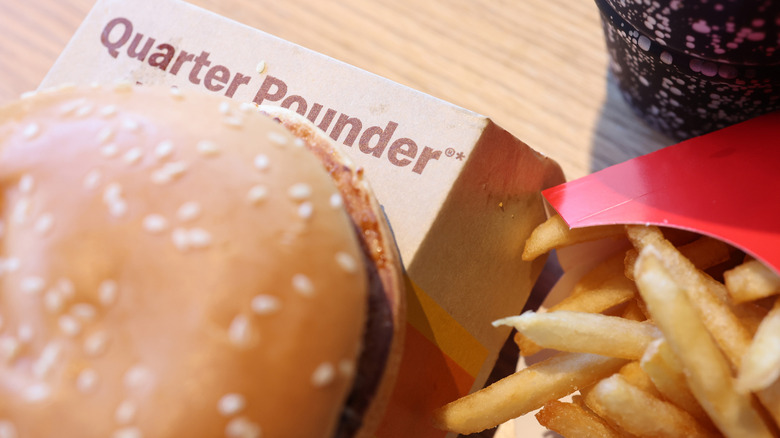
Michael M. Santiago/Getty Images
It's hard to imagine McDonald's without its signature burgers, but the unthinkable happened in October 2024: McDonald's took its famous Quarter Pounder burgers off the menu at 20% of its stores across the U.S. No doubt it was a difficult decision, but it had to be made since it came on the heels of a confirmed E.coli outbreak.
News of the situation first emerged when multiple people in Colorado and Nebraska reportedly ate McDonald's Quarter Pounders shortly before getting sick and showing symptoms of an E.coli infection. The situation became so serious that multiple offices — including the FDA, CDC, and USDA — became involved. Before the month ended, CNN reported 49 related illnesses and one death; by November 11, there had been a total of 104 reported cases across 14 states that were linked to the outbreak.
It wasn't immediately known what the real cause of the outbreak was, but McDonald's quickly acted to prevent more customers from getting ill. The fast food chain removed Quarter Pounders from its menu while public health officials investigated. When reports came that the slivered onions used on the burgers might have been the cause of the outbreak, McDonald's took further steps to change the supplier for its stores in the 14 affected states.
Other fast food chains temporarily dropped onions from their food due to E.coli outbreak
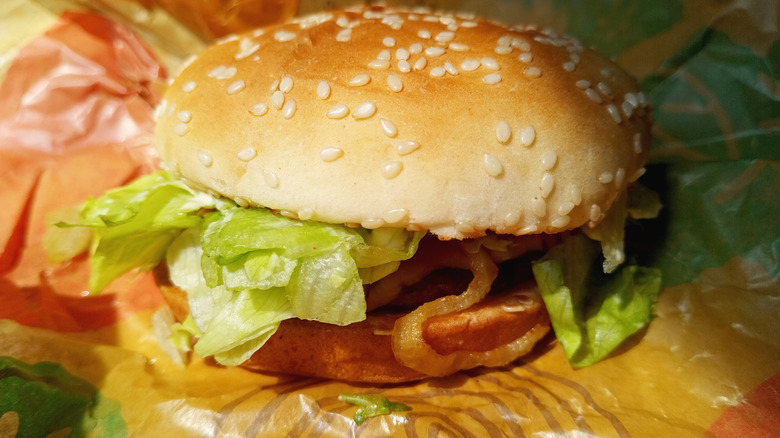
Nadifal 3D Modeller/Shutterstock
Soon after catching wind of the multiple reported illnesses and one death that was associated with the McDonald's E.coli outbreak, the FDA confirmed that the supplier of the suspected contaminated onions was Taylor Farms, one of the world's biggest fresh-produce farms that supplies fresh fruits and vegetables to restaurants and food chains all over the country and abroad. The FDA also reported that the farm voluntarily recalled yellow onions produced in one of its facilities in Colorado.
Following these announcements, Burger King, which also happened to buy its onions from Taylor Farms for 5% of its restaurants, temporarily removed onions from the menus of its affected branches. YUM! Brands followed suit and announced within the month that it was also pulling onions off the menus. The company manages famous fast food chains like KFC, Pizza Hut, and Taco Bell. Although YUM! Brands did not disclose its supplier, the company decided to remove fresh onions from its menus temporarily as a precautionary measure.
Subway stopped using artificial ingredients for its subs and sandwiches
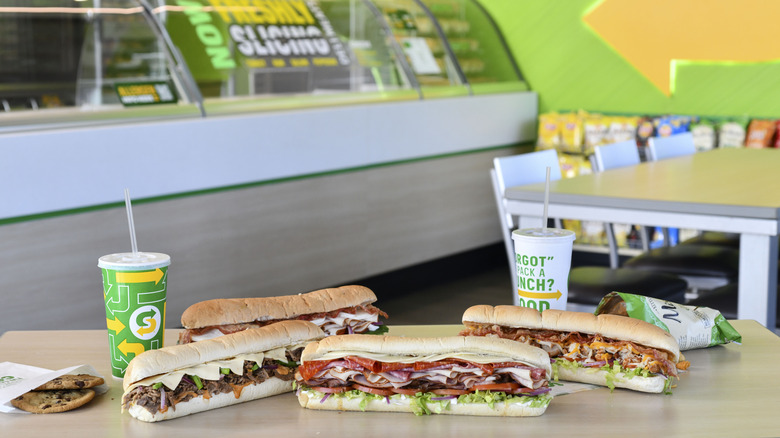
Gerardo Mora/Getty Images
Let us briefly journey all the way back to 2015. Avocado toast was literally the toast of the town, and labels like "natural" and "real" got tossed around a lot as consumers became more conscious of the nutritional value and sources of the food they eat. Consumer Reports conducted a survey the year prior and found that 59% of shoppers at the time were looking for the word "natural" when shopping for food.
At this time, the FDA still didn't have an official definition of "natural" food products and components. As such, food manufacturers, restaurants, and fast food chains used the label on just about any product that would pass the vague criteria of "natural" food.
Subway saw the gap in regulation as an opportunity to appeal to more discerning customers. It announced in June 2015 that it would remove all artificial flavors from its menus across North America by 2017. Some of the first things to go were chemically derived additives and preservatives, like propionic acid, which it used for preserving cold cuts. Propionic acid is naturally occurring, but repeated exposure can cause adverse reactions like a sore throat, headaches, chills, and fever. Subway also discontinued the artificial caramel food coloring that used to go on its roast beef. It started using turmeric instead of Yellow No.5 dye, which was traditionally used on banana peppers.
Domino's started offering gluten-free crusts (but with disclaimers)
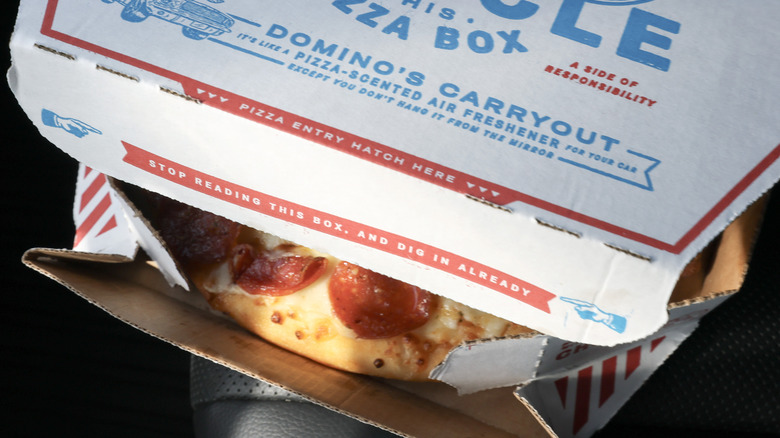
Joe Raedle/Getty Images
Before facing scrutiny for refusing to define "natural" food and ingredients for years, the FDA had been under fire for not having stricter regulations about "gluten-free" labeling for a long time. Sometime around 2010, the public became more familiar with celiac disease and how people diagnosed with it cannot eat food with gluten. Wheat bread, pasta, and cereals can make them severely ill. For some patients, it could even be life-threatening.
In 2013, the FDA ruled that "gluten-free" or "no-gluten" labels may only be used on food with less than 20 parts per million (ppm) of gluten. It's not the ruling celiac patients hoped for: It allowed a loophole for food with gluten to be advertised as gluten-free. This put Domino's under public scrutiny, because the company announced that it worked with National Foundation for Celiac Awareness to create a gluten-free pizza crust. When the FDA ruling came to light, gluten-sensitive customers scrutinized Domino's closely, wondering if its pizzas are truly gluten free.
It is unknown if Domino's had to adjust its recipes to ensure its pizzas met the FDA criteria. Nevertheless, the pizza chain issued a disclaimer on its menu (which is shown when you order on its website) that although its pizza crusts are truly gluten-free, they are prepared in a common kitchen and may be cross-contaminated with gluten-rich ingredients. Today, Domino's warns customers with celiac disease to order gluten-free pizza at their own risk.
Olive Garden changed the recipe for its iconic breadsticks
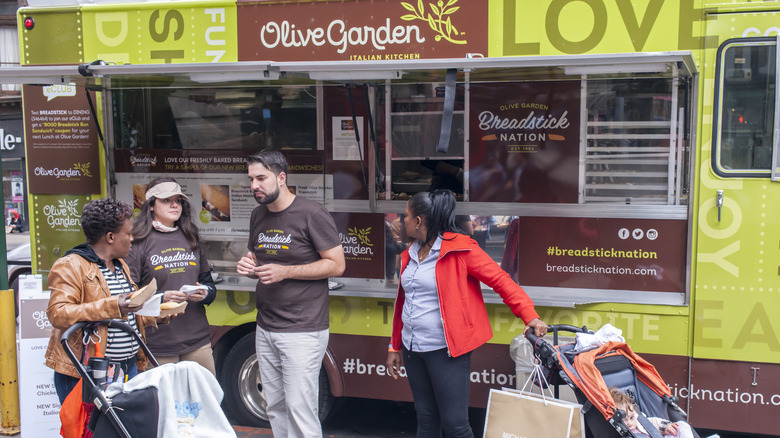
Richard Levine/Getty Images
The FDA has a list of major food allergens in the U.S. It currently has nine items: milk, eggs, fish, shellfish, tree nuts, peanuts, wheat, sesame, and soybeans. The most recent addition is sesame. The FDA declared sesame as a major food allergen in 2021 after the Food Allergy Safety, Treatment, Education, and Research (or FASTER) Act was passed into law. Unfortunately, many food manufacturers and flour suppliers added sesame to their formulations instead of removing it entirely.
Here's the problem: Food manufacturers aren't restricted from using food allergens. They are simply required to declare if any of the nine allergens are part of their recipes (in the case of sesame, it had to be included in food allergy labels by January 2023).
This brings us to Olive Garden. With suppliers circumventing the FDA declaration regarding sesame, the casual dining restaurant chain discovered it was receiving flour that contained a minimal amount of sesame flour (less than 2%). Olive Garden had no choice but to update its allergen guide to inform diners of the change in the recipe of its breadsticks. Loyal customers were unsurprisingly disappointed considering Olive Garden had always been known for its allergen-free menus. To the company's credit, it pivoted as quickly as it could and sought out alternative suppliers for its flours. By October 2023, Olive Garden announced that its breadsticks were once again sesame-free.
Multiple chains changed their recipes in response to the trans fat ban
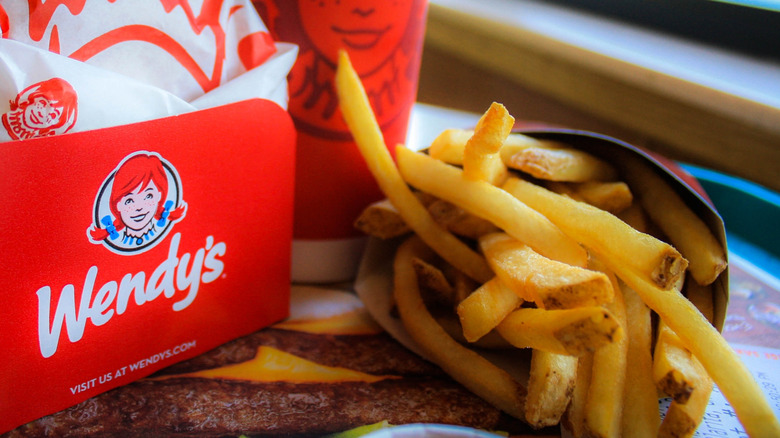
Peach13615/Shutterstock
Fast food chains, restaurants, and food manufacturers once used partially hydrogenated oils (PHOs) extensively. PHOs are a major source of trans fat. They were widely used for frying perfectly crispy French fries, grilling burger patties, baking in-store bread, and more. PHOs had become so ingrained in the American diet that they reportedly caused 20% of heart attacks and 50,000 deaths in the country every year.
And so, after over a decade of debates and discussions, the FDA issued a labeling rule requiring food manufacturers, restaurants, and fast food chains to include trans fat content in nutritional labels as of January 1, 2006 (this led to New York City becoming the first city in the country to totally ban trans fats in all food service establishments). In light of the growing public awareness, research studies, and increasing epidemiological evidence about the dangers of trans fats, many fast food chains pivoted and went with the tide to eliminate PHO from their menus.
Wendy's was the first to transition to using healthier oil substitutes for the fried food on its menus in 2006. Burger King, Chick-fil-A, McDonald's, and KFC announced similar moves the next year. Other fast food companies gradually followed suit in the next few years, pledging to significantly cut down unsaturated, artificial fat from their menus, if not going completely trans fat-free.
Some Cinnabon locations stopped using trans fats for their cinnamon buns
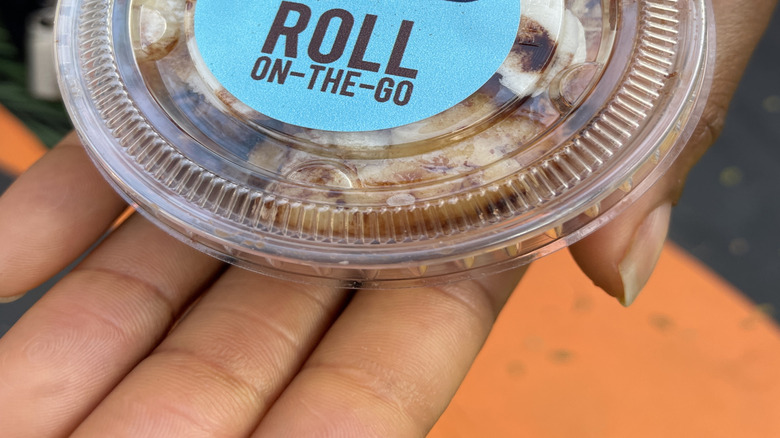
Jenari/Shutterstock
Fulfilling its mandate to protect public health by regulating the use of food products or ingredients that are potentially harmful, the FDA passed a preliminary determination revoking the GRAS (generally recognized as safe) status of PHO in 2013 and made it final in 2015. At that time, margarine and vegetable shortening were prime examples of food products with PHOs.
PHOs were a popular additive to frozen, microwaveable, deep-fried, and baked food items. They're widely used in the food industry because they're cheap, have a longer shelf life than saturated fat, and solidify at room temperature. They helps cakes and soft pastries hold their shape, hence their use in bakeries like Cinnabon.
It is widely known that Cinnabon adds margarine to its buns. Margarine has a low melting point and makes cinnamon rolls soft, gooey, and tasty. Unfortunately, margarine adds to the trans fat content of Classic Cinnabon Buns, bringing the total trans fat of one bun to 5 grams.
The FDA didn't enforce an immediate ban on the use of trans fats in 2013, but it required food manufacturers and food services to phase out PHOs from their recipes by 2018. And so, many Cinnabon stores, particularly those in New York and California where the trans fat ban is actively enforced, changed the recipes for their buns and the rest of their menus. The nutrition chart on Cinnabon's website now shows 0-0.5 grams of trans fats on all in-store menu items.
Burger King stopped using artificial ingredients not approved by the FDA
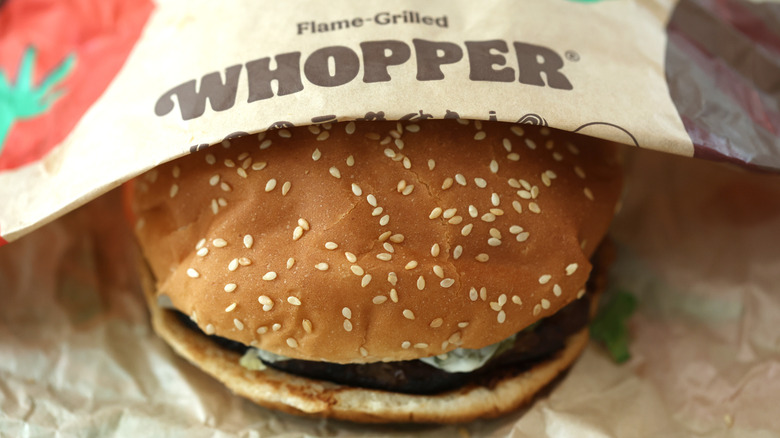
Justin Sullivan/Getty Images
No one would think of using moldy food to advertise a menu item, but that's exactly what Burger King did in 2020 when it released the "Moldy Whopper" ad. It was a risky yet smart move that targeted a large market of people who wanted to consume more "natural" food. Based on the timing, it may also have been spurred on by the successive FDA rulings against trans fat and artificial food additives in previous years.
The following year, Burger King released a list of 120 blacklisted Ingredients that it would no longer include in its recipes. It consisted primarily of food colorings, various types of sodium, and PHOs. The food chain pledged to replace these ingredients with natural counterparts, while preserving the flavors of its beloved food items as much as possible.
Burger King followed up this announcement by launching "Keep It Real Meals," a campaign with famous artists like Nelly and Anitta. The campaign's message? Burger King serves food so real, celebrities agreed to put their real names on the meal sets. For the duration of the campaign, Burger King menu boards had the Larissa Machado Meal (Impossible Whopper with fries and Sprite) and Cornell Hayes Jr. Meal (classic Flame-Grilled Whopper with cheese, fries, and Sprite).
In-N-Out Burger replaced old ketchup and changed the recipes for its Strawberry Shake and Signature Pink Lemonade
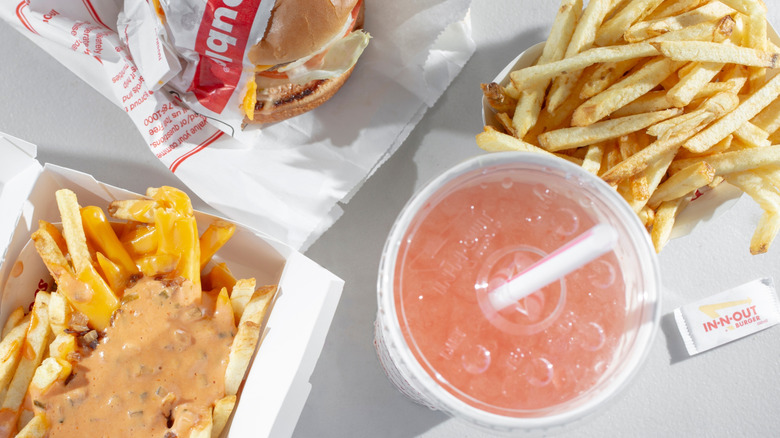
The Image Party/Shutterstock
In April 2025, the FDA made major announcements about new regulations that would force many food establishments to reformulate recipes in order to stay compliant and avoid federal sanctions. The latest FDA ruling was to gradually phase out artificial food coloring from all food products, especially petroleum-based dyes.
Soon after the announcement in May, In-N-Out Burger announced that it is switching up the recipes for its Strawberry Shake and Signature Pink Lemonade, both of which had some of the banned artificial dyes. In-N-Out also wanted to replace its ketchup, which was made with high-fructose corn syrup, with ketchup that uses real sugar for sweetener.
In-N-Out proudly shared on Instagram that it had been actively removing artificial ingredients from its menus since 2017. For instance, it stopped using artificial chocolate flavoring for its chocolate syrup and shake mix. It also replaced the Yellow No.5 food coloring on its chilies and pickles with turmeric.
McDonald's may have to adjust its menu due to the latest ruling against artificial food dyes
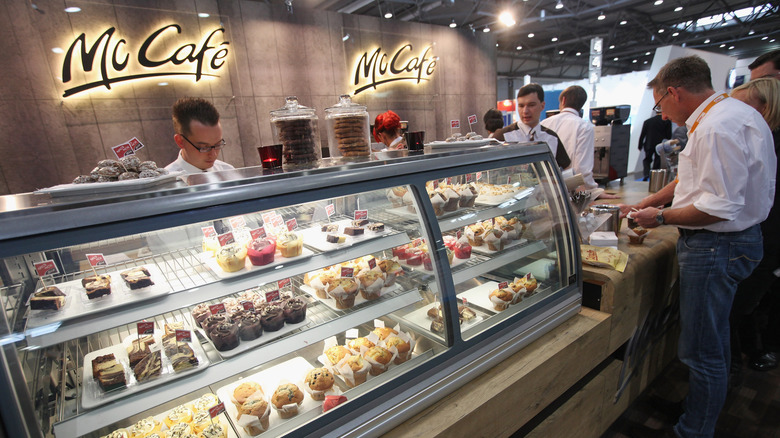
Sean Gallup/Getty Images
The FDA's ban on artificial food coloring targeted artificial dyes commonly used in sodas, juice drinks, candies, and imitation or vegan meats. Notice that some of these food items are staples in many fast food joints. Unsurprisingly, industry watchdogs quickly pointed out that McDonald's has a lot of items on its drinks and desserts menus that would be affected by the ban.
First up is the M&M McFlurry, which features the colored candies that use a bunch of the artificial dyes named in the FDA ruling. McDonald's also serves Fanta, which contains the newly banned Red 40. Another hit is the McCafé Mocha Frappe, whose mocha base also contains Red 40. Seasonal drinks like the Shamrock Shake for St. Patrick's Day and the Grimace Shake are also suspected to contain some artificial dyes. If that's truly the case, McDonald's may have to reformulate these drinks if it plans to bring them back on the menus next year.
Culver's has several menu items that are are also up for an upgrade because of the artificial food dye ban
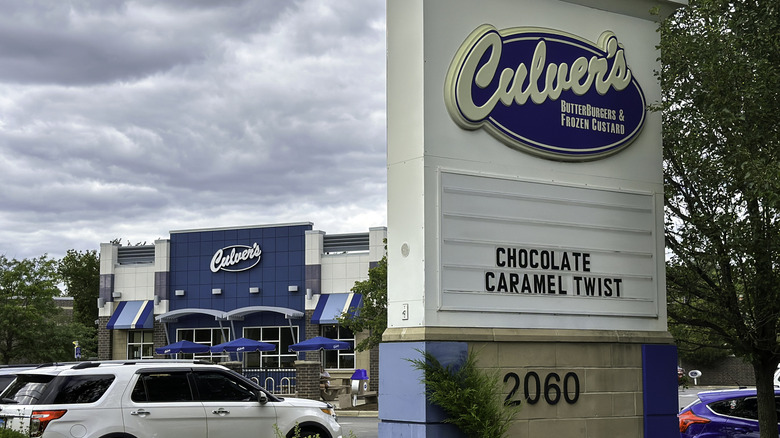
Patty_c/Getty Images
Culver's, the beloved fast-casual restaurant chain, is also in the same boat as McDonald's. The latest food dye ban compromises several of its menu staples, not just the desserts. For instance, one of the salad dressings it offers, Ken's Raspberry Vinaigrette, contains two banned artificial dyes: Blue No. 1 and Red No. 40. The dill pickles also have the banned Yellow No. 5.. Culver's root beer and the carbonated drinks it serves like Fanta, Mountain Dew, and Tropicana Lemonades are also in violation of the new FDA ruling.
This phaseout of artificial food coloring is shaking up the fast food industry, with some already complying with the new mandates. As the FDA continues its task of protecting public health through appropriate regulation, we look forward to seeing how fast food chains will respond to this and any future mandates by the agency.



